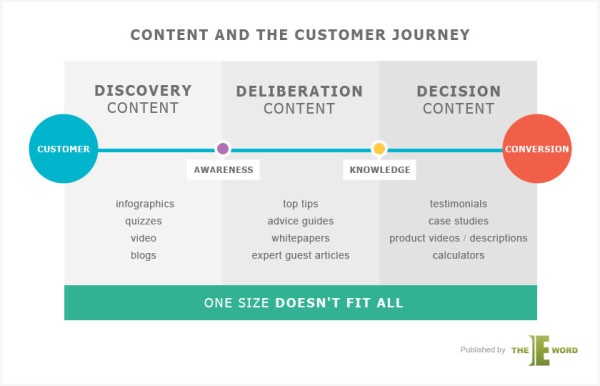Introductions are difficult. From social situations to sales pitches, you only get one chance to make a good first impression.
Get it right and you have yourself a captive audience. Get it wrong and you often won’t be given a second chance.
So, how do you create a killer intro that’s going to have your audience hooked and keen to know more? Step right this way, and let theEword be your guide.
Make the subject clear
The heatmap diagram below shows where readers are most likely to look on an average page. The data is based on cursor positioning, on the assumption that the reader’s eye will follow the cursor. As you can see, the opening paragraph is a real hotspot, so this needs to be strong.

People landing on your site will often have a fairly clear idea of what they want, and your introduction should tell them that they’ve come to the right place. But how?
Kissmetrics co-founder Neil Patel suggests you avoid simply repeating what’s in your title. You can see that I’ve kept my title short and then used the intro to expand on what I plan to say. Repetition is one of the most boring pitfalls of blogging and is a sure-fire way to drive your readers away.
Think of your intro as a summary. Almost like a pre-conclusion. You’re telling the reader what they’re about to see, but without giving so much away that they stop reading. For example, my introduction tells you the question I’m asking, but it stops short of providing the answer.
Tell the reader why they should care
While it’s necessary to tell the reader what they’re looking at, it’s even more important to tell them why your content is worth their time.
Last year, we wrote a piece on how different types of content can attract people at different stages of the customer journey. As you can see, we’ve positioned blogs near the start of that process, in the Discovery phase. Notice too that this phase comes before people are even aware of your business.

In other words, the introduction to your blog could be the first contact they have with your company. You need to outline early on what they’re going to get from your content, and there are various ways to do this.
In the intro for this piece, I’ve spelled out the question that I imagine you’re asking. While I haven’t given you the answers in the intro, I have made it clear that you’ll find them if you continue reading. That’s where the value is here. That’s my ‘hook’, and if you’ve read this far then it must have worked. Hope you’re enjoying yourself so far.
Put the reader at ease
When it comes to blogging, you have a little more leeway to set the scene than you would with a piece designed for readers further along the customer journey (such as a case study or product description). Readers will expect the style to be conversational, so it’s good to inject some personality into proceedings.
Be careful though; if you’re 200 words in and you’ve still not got to the point, then unfortunately you’re likely to lose people along the way. Ronnie Corbett can get away with it. You probably can’t.
Establishing common ground is a good way to welcome your readers. The awkwardness of introducing yourself to new people is something we’re all faced with on a regular basis, which is why I featured it so prominently in my introduction.
Addressing your reader directly from the start is also a good method of communication. My intention is to make you feel like we’re having a one-to-one discussion. I address ‘you’ and ‘your’ questions six times in my intro. Crucially, this occurred quite naturally. If you start shoehorning this kind of thing into your intro, it’ll sound false and people won’t buy it.
Authority is also key to the success of your introduction. Your use of language is significant here, as you want to show that you have confidence in what you’re saying. Consider this sentence from my intro:
So, how do you create a killer intro that’s going to have your audience hooked and keen to know more?
The key moments here are ‘do’ and ‘is going to’. You can easily replace either of these with ‘could’ or ‘might’ and still have a grammatically coherent sentence. However, it doesn’t sound nearly as convincing.
Offering a solution that will work is preferable to giving your reader advice that might work. After all, if you’re not sure, why on earth should they be?
Mix it up
Your blog should be a carefully cultivated resource, housing all the pearls of wisdom that will make your visitors love your content. Unless you’re planning to only ever write one blog, you need to keep things varied if you want people to continue coming back for more.

There are a number of ways you can achieve this:
Ask questions
I asked one in my intro, and they’re an effective way to kick things off.
Remember, most searches stem from the need to answer a question. Position yourself as the problem solver.
Tell a story
Many blog topics are chosen based on the writer’s personal experience. As such, it sometimes makes sense for an anecdote to form the basis of your intro, particularly if that anecdote can be used to establish common ground.
Just remember the Ronnie Corbett rule from earlier, which is that You Are Not Ronnie Corbett. Don’t ramble.
Use facts
Starting with a fact will lend weight to your piece and get your readers thinking. The first three words of my intro don’t constitute a pure fact – some lucky devils probably find introducing themselves very easy – but it’s close enough that plenty of readers will be nodding in agreement and keen to know about how to combat this problem.
If you have them, data-led statistics will give you a really good base to build on for your piece. Consider this piece we wrote about the use of visual elements in your content. Here’s the first line:
Using images in Facebook posts can increase the number of likes received by 732% and increase engagement by 418%, while using them in tweets can encourage 62% more clicks.
A 732% increase? 418% more engagement? Who wouldn’t want to know how to achieve figures like that?
Revisit and rewrite
It makes sense to read your introduction again once you’ve finished writing your first draft. Rewriting is part of writing, and it’s worth spending a little extra time on your intro to get it absolutely right.
You will often find that the piece has taken a different direction to the one you originally intended. You might have uncovered new research or information along the way that sent you off on an unexpected tangent, or you might simply have decided that your original idea wasn’t very good. In these circumstances, it would be silly not to make changes to your intro.
Some writers even go as far as writing their introduction last, once they can see how their post has panned out. I don’t mind admitting that I went back and amended my original introduction to help me illustrate some of the points I’ve made in this piece.
Want more content writing tips?
Now that you’ve got your intro sorted, perhaps you’d be interested in some more advice to help you improve the content you’re creating?
We’ve put together numerous hints and tips, from making people love your content to the art of storytelling.
Come back and see us next month too, when we’ll be telling you how to create the perfect conclusion.
Finally, to help you plan your content and take a methodical approach to building your audience, why not download our free calendar?


